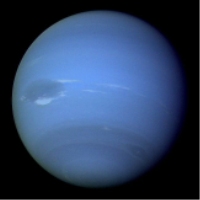
Neptune, the eighth planet out from the Sun, was the second planet discovered by telescope. It is similar in size and composition to Uranus. However, like Jupiter, it gives off more energy than it receives f rom the Sun. The discovery of Neptune by Joseph Galle in 1846 was a triumph for mathematics: the planet's position had been predicted by Adams and Leverrier in 1845, based on observed irregularities in the orbit of Uranus.
Galileo may have seen Neptune with his rudimentary telescope in 1613, when Jupiter and Neptune were in conjunction. His observing records show a "star" that doesn't appear in modern star catalogues. If indeed Galileo did observe Neptune, this would double the period of time over which it has been observed. Its orbit still isn't very well defined; since its discovery in 1846, it hasn't yet made one complete orbit - one orbit around the Sun takes Neptune 164 years and 280 days.
Neptune was named after the Roman god of the sea because of its bluish colour. Like all the other gas planets, it has a rocky core which is surrounded by a "mantle" of water, methane and ammonia ices. Above the mantle is an atmosphere of hydrogen, helium and methane gases, forming thick clouds. Giant storms rage in the atmosphere. The biggest storm is the "Great Dark Spot - as wide as the Earth, and similar to the Great Red Spot on Jupiter.
Neptune has 5 faint rings and 8 moons. The largest moon, Triton, is larger than the planet Pluto. It orbits the opposite way (retrograde or clockwise) to most other moons in the Solar System. Some scientists think that millions of years ago, a large object passed close to Neptune and caused Triton to reverse its orbit, forced Nereid to go into a highly elliptical orbit, and perhaps also ejected Pluto which may at that time have been a moon of Neptune.
Neptune's orbit around the Sun is nearly circular. Only Venus has a more circular orbit.
Physical Data
Neptune diameter: 49 528
km
Minimum distance from Earth: 4 359 million km
Distance from Sun: 4,509 million km Period of rotation: 15.8 hrs
Period of orbit: 164.8 yr
Number of moons: 8 (+ ring system)